This part of Africa on the Atlantic coast is quite tricky: between the southern parallels 5° and 6°, from Pointe-Noire (Congo) to Soyo (Angola), there are three border crossings within less than 200 kilometers. And those are not easy countries to get in: the Democratic Republic of Congo (DRC, ex Zaire) and Angola.
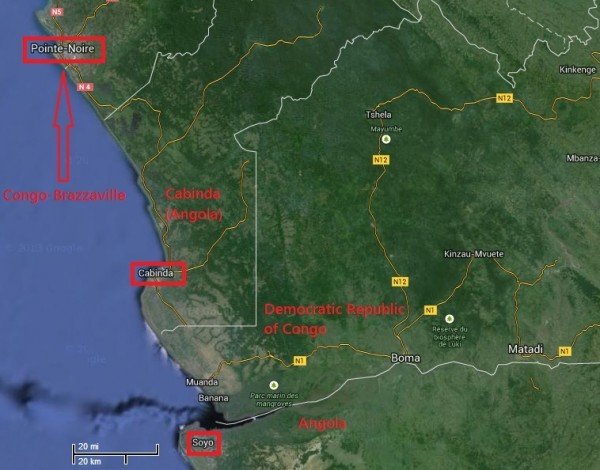
With my 30-day visa for Angola surprisingly easily acquired, my plan is to cycle from Pointe-Noire to the Cabinda exclave, this tiny part of land belonging to Angola, squeezed between the two Congos. From there, I would take a ferry to Soyo, around the short coast of DR Congo and the Congo river mouth, until Soyo, the northernmost city in “mainland Angola”.
As I wake up in Djeno, I reach the border in Nzassi very quickly for breakfast and money changing. It is the last place where I can use the CFA Franc, as I am leaving the huge francophone monetary area. The trade is 5 CFAs for 1 kwanza, and 100 kwanza make nearly 1 USD, so it is easy to juggle with the numbers.
Once on the other side of the fence, I am in Angola, in the Cabinda enclave (but technically only an exclave), this country known for not allowing tourists in and for its recent 27-year civil war. The border town is called Massabi, and the striking feature is the presence of so many ATMs and banks (and nothing else). In which African country do you find ATMs at small border posts? Well, the war-torn image of Angola doesn’t seem to fit with the reality. And as a remark about ATMs, they are all over Africa, at least in the main cities. Whenever I read something in the Lonely Planet guides, it is said to stock up on cash before visiting because they are no ATMs. It is completely wrong, as so many other things. I read some things in the LP that anyone with a week spent in the country would not mistake. They are quite useless, especially considering that the state of the sights and the prices change every year.
I am prepared for difficulties at the immigration post: “Where did you get this visa? It’s not valid!” and other nonsense that makes the “charm” of African border crossings. And it does not fail: the officer, alone in his small (air-conditioned) booth, takes my passport and makes me wait. The official language of Angola is Portuguese, the officer doesn’t speak anything else, so we don’t really understand each other.
I wait there, with my bicycle, for about an hour. Are they checking my profile on their terrorist databases? Are they calling Luanda to scold the Pointe-Noire consulate for having granted a visa to a tourist? It could be anything. But when the officer comes back to me, it is actually because they ran out of forms for foreigners entry. It was only that. I fill it, describe roughly my itinerary through the country until Namibia, and go. Very easy.
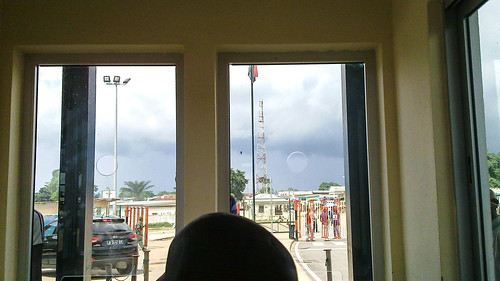
Cabinda is marked in red on the French travellers’ advice website, meaning “absolutely avoid this area”, just like northern Nigeria and most of Iraq. I learnt not to follow this kind of exaggerated advice. The reason is probably the attack of the bus of the Togolese football team in 2010, killing three, by the FLEC, the Front for the Liberation of the Enclave of Cabinda. To understand the reason, one has to read the history of Cabinda, formerly the Portuguese Congo, and the Angolan civil war. By the way, Emmanuel Adebayor was in this bus.
In short, when Portugal finally agreed on the independence of Angola in 1975, the country was left in the hands of three liberation movements, who then fought against each other for the control of the free country: MPLA (the winner and current ruling party, backed by Cuba and the Soviet union), UNITA and FNLA, backed by the Western nations, in a fight against communism, and by South Africa, whose land comprised Namibia at that time. As a fourth player, the FLEC, backed by France, fought for the independence of the province of Cabinda. When the civil war ended in 2002, the FLEC only continued its operations. Today, it is relatively quiet, but a huge part of the Angolan army is based in Cabinda and the FLEC resistance must hide in the bush.
What must be said is that Cabinda accounts for about 60% of the oil exports of Angola. Just like off the coast in Pointe-Noire, the reserves of oil ashore from Cabinda are huge. “Oil exports from the province are worth the equivalent of US$100,000 per annum for every Cabindan”, so no wonder why Cabinda wants independence and why the oil-rich Angolan politicians don’t.
For me, on the road, I witness nothing of this. It’s just hot, really too hot. The sun is burning my face. The road is good, the cars look good too.
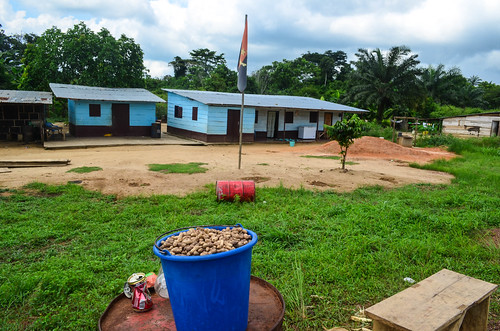
I heard this story of foreigners, mainly Congolese, staying and working illegaly in Cabinda, being expelled from the province in large trucks. The method made Congo close its borders with Cabinda for a while, and it was more annoying for the Cabindans: their port being small, and cut from mainland Angola, they get most of their supplies, including food, from Pointe-Noire. However, I don’t see too many trucks on the road like at the border Cameroon-Gabon, where all the fruits of the Gabonese, and basically anything edible, are imported. Well, Congo doesn’t produce much either, it is not a destination for food lovers.
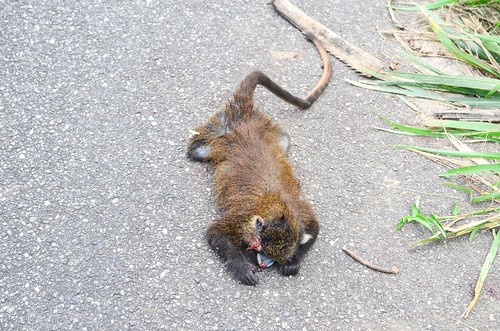
I see many bush meat stalls, people selling only the food they could hunt. Some people speak French, but my Spanish is still to adapt and to convert into Portuguese.
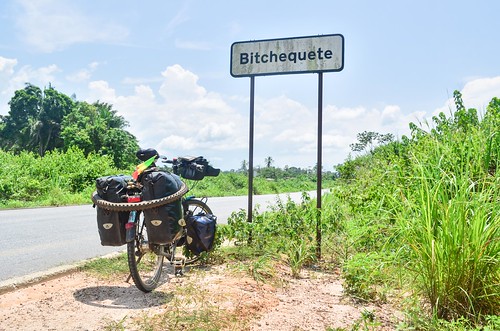
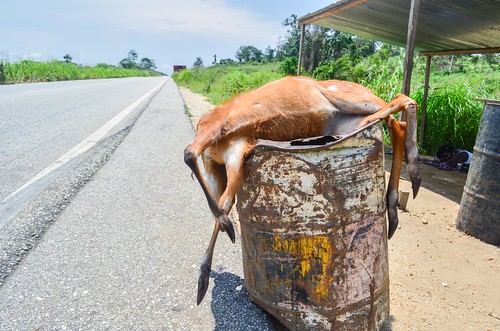
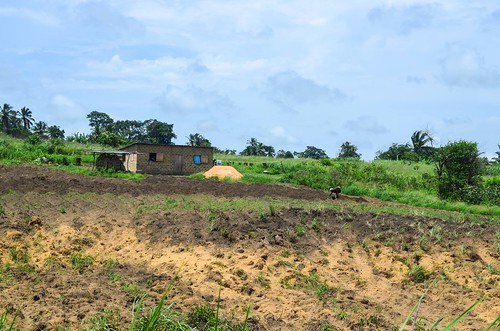
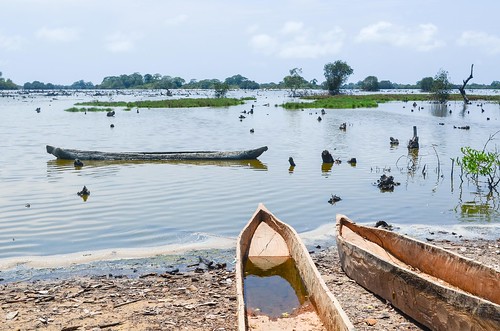
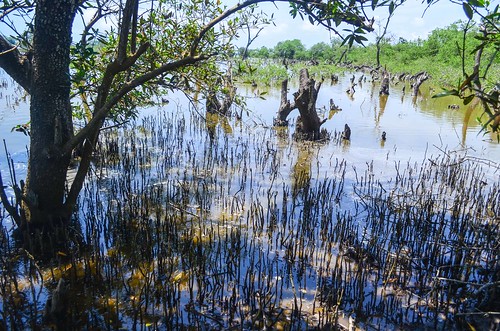
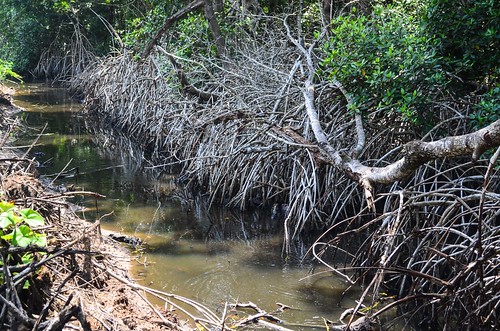
When I reach the first town, Landana, it is time for lunch. The price quoted for a plate of stuff is 2000 kwanza, 20 USD. Really, for a road side food? It is my first contact with the crazy Angolan prices. I finally switch for the cheapest option, fish and rice for 4 USD, the same plate that would be 1 USD elsewhere in West Africa. I guess I have to get used to the fact that the people living in the same standards and conditions as elsewhere now sell the same food for much more money, and stop comparing it to the cheap food places like Cameroon and Ivory Coast.


Angola should mark the end of the rainforest and the greenery that surrounds me since Guinea, but Cabinda is still very green and watery. On the coast, I see many oil platforms, the wealth of Cabinda (and thus Angola).

The roads are very quiet (it’s too hot to be outside anyway) but there are many military checkpoints, normal checkpoints, rather friendly, and trucks passing with soldiers. Electricity and water are almost everywhere, among Chevron ads.
I buy a SIM card, from the Unitel network, at the first opportunity I have. The lady accept the note of 5000 CFA that I forgot to change at the border. By hiding money a bit everywhere, I end up crossing borders forgetting to change every single bank note I have. The SIM card usually cost close to nothing, but it’s 5 € here. Hmmm. On the other hand, there is one thing cheaper in Angola: gas. Unleaded gasolina is at 60 kwanza (0.45 €) per liter, diesel gazoleo is at 40 kz (0.3 €). It would make overlanders in gas consuming 4×4 happy, but my bicycle is insensitive to it.



Sonangol is most likely the main industrial employer of the country. Owning the oil fields and partnering with Chevron, Total, Eni and other giants, it apparently managed to attract very skilled workers and managers, who are very close to (being) politicians as well.
Between Landana and Cabinda, a long segment of road on the right hand side is fenced with barbed wire, and probably with mines too. It is the Malongo camp, a protected area for oil workers. I heard they are locked inside for their safety, and so as to avoid kidnappings they only travel by helicopter to the airport or to somewhere else than Angola. It is not a fun life at all, their salaries must compensate for this. I think the American Chevron is the biggest player in the camp, but the French Total also exploits the fields there.
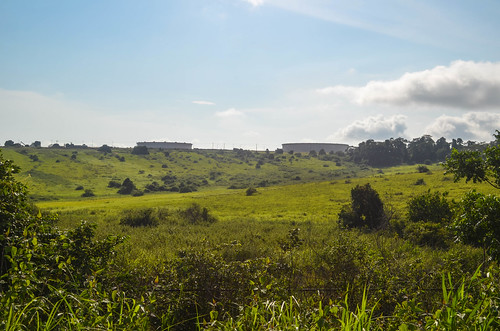
During the civil war, this “Kuwait of Africa” was still operating. The Bradt guide, incredibly better than the LP, reads that “at one stage in the awful conflict here, there was the glorious incongruity of American oil workers in a communist state being protected by Cuban troops from anti-government rebels (UNITA) funded by the American government“.
After more than 120 km for the day, I reach Cabinda city, the capital of the Cabinda province. I wanted to avoid sleeping in the bush, because even if everything looks safe, Chinese have been kidnapped and killed recently. The entrance of the city looks good, with buildings under construction and the brand new stadium used for the African Cup of Nations in 2010, with the national animal of Angola, la palanca negra (the great sable antelope), posing in front of it.
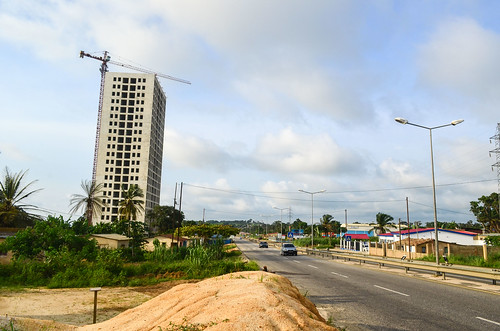

Cabinda looks nice, I would say pretty civilized for an African city. I met Portuguese people on the road who can host me tonight, but before sunset, I first look for the port. I need to know when and where will the ferry depart to Soyo, on the other side of DR Congo. The boat is actually not departing from the port, but from the playa, the beach a bit eastwards. The path to the beach is not easy and once found, I am told it’s not here: “you must go to the other one“. It is almost night and I still don’t know where I will find my host tonight.
Right at the moment I am in a hurry, a car at a crossroads stops and the driver asks me to stay for a chat, with the usual annoying questions, where do you come from, blablabla. I have no time! Unfortunately, the man is a policeman and I can’t run away. Fortunately, he is responsible for the beaches of Cabinda and he wants to help me. He doesn’t know the boat schedule but he will take me where people know. So we drive and cycle together until where the boat leaves.
On the beach, dirty and without any office but a small police shack, I am quickly surrounded by ten helpless people, it is getting dark and obtaining information is a pain: one of them speaks English, but if he didn’t mention it was English, I’d have said it was Chinese. I ask questions but his answers sound suspicious: too many “Yes” in a row. People reply with either Yes or No all the time when they don’t understand. In the middle of the conversation, out of nowhere, the policeman jumps in and asks to see my documents. No way! After 120 km, including a border crossing and a burning red face, I have no patience and I escape the crowd and the policeman becoming weird. I don’t have the information I wanted.
I can’t do any more climb but there are small ones within Cabinda city. I head to the address of Fernando, where I arrive completely tired, physically and mentally. After a warm shower, I sit at a table with vinho tinto, bush meat and cheese. It instantly becomes better. Much better!
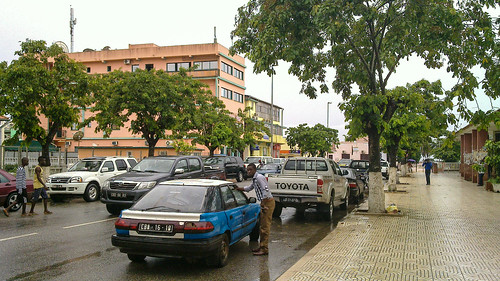
Fernando is working, among others, for the federation of athletics of Portugal. Having myself been holding an athletics license for several years, I feel related. At the table, sitting are Cabindese (not to be called Angolans) and Portuguese for a long term in Angola. It is not a secret that one makes much more money working here than in Portugal. A lot of Portuguese have emigrated to their ex-colony for a better salary. Until 2011, Portuguese born in Angola before independence (1975) could ask for the Angolan nationality. It is not possible anymore. My hosts are surprised to see a tourist, with a tourist visa, as if such a thing didn’t exist. Well, I was the first surprised when I received the visa.
Maybe it is common for African countries rich in underground resources to have a very poor population and a ultra-wealthy family of political leaders, but for the case of Angola, we reach the extremes. The data for the Gini coefficient is not complete but Angola must score fairly well. The daughter of the president Dos Santos is the richest African woman, and albeit it is not possible to count the country’s money that has been transferred to his family members, some figures makes him enter the list of the 50 richest men on Earth.
As a result, I heard that the president received top notch security equipment from the Mossad. No rebellion is allowed. Cabinda has most of the Angolan oil, most of the rebels fighting for independence, and most of the army posted here.

For once, I should be careful. I find it interesting and relevant of the society that presidents can rule in Africa for 30 years without building a much needed road, and I like to ask the low classes of the population (the overwhelming majority and the quasi totality of the rural population, hence the people I spend most of my time with) what do they think about the president. However, in Angola, the state is paranoid about spies, rebels, journalists, tourists, etc. I am told not to discuss openly these sensitive topics as there could be micros hidden and people innocently listening to me and reporting. Thus I should feel already blessed to have my 30-day visa and keep quiet. Foreign workers admitted in Angola can be sent home if they talk about politics (it’s illegal for them) so they should be careful. Many international oil companies, such as Chevron, Total and Eni/Agip, are operating in the Cabinda oil fields, so the USA and France have reasons to keep quiet about Cabinda, although it has originally no ethno-cultural bondings with Angola. I will be busy anyway, trying to cycle the whole length of the country, 2000 kilometers, in less than 30 days.
People usually fly from Angola, Luanda or Soyo, to Cabinda, which explains why there are no easy overland routes. Few people know about DR Congo, apart from the fact that the dirt roads are bad, it takes ages (3 days from Luanda) to cross and too many bribes are demanded once the Congolese see the Angolan license plate, a sign of easy money. Even cars and trucks are sent to Cabinda via cargo airplanes.
On the other hand, Xavier in Djeno told me a traveler managed to enter DR Congo from Cabinda, without visa, and cross the 30 kilometers until the Congo river mouth, where canoes make the link with Soyo. I will try that tomorrow. Fernando says Angola is actually pretty safe everywhere except in the capital Luanda, also known as the most expensive city in the world.
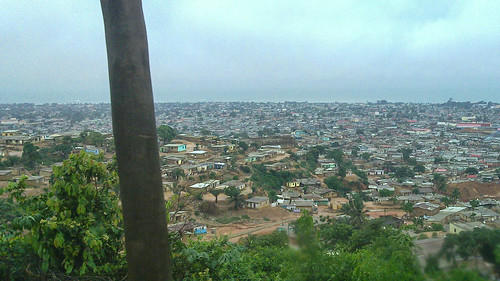
The next day, Fernando takes me to the playa to inquire about the boats. The ferry that used to run between Cabinda and Soyo is there, in the harbor, but not operating. The harbor has to be renovated first before the ferry can run. As a result, the only maritime option is to get a place in a boat from small local businessmen. But these are more like canoes than boat. Big wooden barges, like the overloaded ones that capsize in the Mediterranean sea with illegal immigrants.
The trip is said to last 4 hours and looking at these boats doesn’t inspire confidence. They are called chatas. After all, I have taken tiny canoes and survived, so why not. We negotiate the price, down from 150 USD to 40. The prices are crazy here! People can say anytime “This is 100 USD” without feeling they are doing wrong. They are not really cheating the customer, it is just that prices are crazy. I have the same feeling as when I first moved to Switzerland: “But why are these people selling the same things as elsewhere for double the price?“. I pushed the price of a USB-micro USB cable (for my e-Werk to charge while cycling) down to 8 USD, but no lower: these things are worth 1 USD on the internet. The rooms of an old hotel in the city center are 200 USD. The Maggi flavoring cube is 20 kz: it makes 100 CFA, four times the price in West Africa. The kassava stick of 200 CFA is here 100 kz = 500 CFA. Mobile internet for 100 MB cost 27 USD. It was like 0.5 USD in Cameroon. I picked the 25 MB plan (a ridiculously low amount of data) for 9 USD.
The chata is leaving at 3pm. But when I return there, it is not leaving anymore. “Tomorrow“. Well, that’s how to waste a day. In parallel, all policemen and immigration bosses want to take part in my adventure by asking to see my documents (I am not leaving the country), getting photocopies, and calling their superiors. They represent the police forces that are more of a threat and a source of worries for the population than a help. Fernando has to call his contacts to make it go smoothly and bribe-free. The troubles end up with the middle-boss saying that my multiple-entry visa means “it’s multiple entry as long as you stay in Angola. If you leave Angola, the visa is void and cannot be re-used“… It is the same nonsense as those “unlimited data mobile internet until you reach 100 MB” plans. My visa is multiple entry and it means what it means, not what the ignorant immigration boss wants to interpret. If you want to hear the most stupid things ever, just talk with a zealous policeman in Africa.
Despite the incredibly helpful assistance of Fernando, we are back at the headquarters of their company, where I can sleep in the empty dorm for visiting workers. I now regret not to have applied for a DR Congo visa. I didn’t because I was sure a ferry was running between Cabinda and Soyo, and because DRC is known for its corruption and bad roads. The failed coup and killings in Kinshasa last month finished to convince me it was better to go around.
But after all, I have seen enough shit to run away from the 30 kilometers between Yema (border post) through Muanda until Banana, the port facing Soyo. If it is really possible to get a visa or a laissez-passer at the border, I will give it a try tomorrow. The chata is leaving at 12, so it leaves me time to cycle the 20 kilometers between Cabinda and the border with DRC at the Yema border post. I have nothing to lose.
These 20 kilometers go fast. The bush of Cabinda is not really populated. There are more military than villagers. I count maybe five army camps on each side of the road. Without a visa for DR Congo, I show up at the Yema border post.


I ask the Angolan immigration to let me walk to the Congolese immigration to discuss my entry. I don’t want to be stamped out of Angola and be later blocked at the entrance of Congo. The border is like a mini market. A lot of people are hanging out on the Congolese side, while the Angolan side is rather quiet. As I leave my bike at the office, the young Angolan officer walks me to the other side. The answer of the Congolese is clear and sharp: “No visa, no entry. We don’t deliver anything here“. But there is no way to obtain a visa in Cabinda. DR Congo refused to open a consulate there. There is a hypothetical one in Pointe-Noire, but most likely, one would have to deal with it in Brazzaville (where they refuse non-residents) or Libreville, far away.
It is apparently difficult to get a DRC visa. Another cyclist failed at all the Embassies in countries south of it. I heard it is possible in some capitals in the north. Well, I didn’t apply anywhere and naturally I cannot enter. My last chance is to meet Blaise, a helpful Congolese working at the Yema border post. He previously helped other travelers and I found his name on the internet. Unfortunately he is not there yet.
I call Vemba, the chata man at the Cabinda playa, and I understand the boat is leaving later in the day, which allows me to stay in Yema and play the waiting game. The officials want me out, but I keep on my stubborn position to wait for Blaise. I wait two hours at the gate.
It is Africa, so there is always a solution. It often implies money, but time is more important. Without patience, one cannot succeed. I wait and I wait until Blaise shows up. He looks nice and helpful. He says he will talk to his boss, but that will cost me money. I answer that I would only agree to pay the price of the visa-volant, 40 USD, and no more. Blaise leaves and I wait for another hour.
The visa-volant is a visa delivered at some borders of DRC, if one arrives at the right time of the year and meets the right officer. It is maybe more a legend than anything else, this visa-at-the-border. It is not delivered at this border, but I keep waiting to see if something unlocks. 40 USD is the official price I have read on the internet, but “official” is a word as relevant for them as tartiflette and frost bite: it means nothing.
Blaise comes back to me from time to time. He is in the Congolese immigration office while I am waiting 20 meters further, on a chair at the Angolan gate. All in all, from 9 to 14, I am waiting at the same spot, with nothing to do. It is getting tiresome. But that is the game. If someone really wants something, he must wait. Or know the right people. Often both.
The only distraction is the arrival of a truck full of people from Cabinda. They are made to walk in line through the border. It is probably one of the massive expulsions from the Cabindan territory I have heard about.
Blaise comes back to me another time, and finally says I can enter. Really? Magic! Well, low-profile magic, as the solution he found is not ideal: he said they had to call their regional boss in Matadi, who called the national boss in Kinshasa, to obtain the permission to let me go through DR Congo. The condition is that I must leave the country by the end of the day. I am not granted a visa. And I have nothing to pay.
Well well … cycling between 30 km and 50 km of dirt roads after the rain from 3 pm is a challenge … I’d have to go fast. I run to the Angolan immigration office to get my exit stamp, pick up my bike and enter DR Congo. There is no time to lose, and I am excited to be doing something “a priori impossible”. We sit together with Blaise and the chief of the immigration, who makes me understand they are doing me a favor of letting me go through, and that I will take a 4×4 with a police escort until the Banana wharf, where I will embark onto a canoe for Soyo, Angola. Hmmm … it is not fun, but still more convenient than taking the dodgy chata from Cabinda. I agree to pay the 30 USD for the short 4×4 trip and we proceed onto the immigration procedure: I don’t receive a visa but they record my fingerprints anyway. I thank Blaise a lot. I load my bicycle and panniers in a 4×4. This one is slow to leave. I unload it and put it in another car. However, the policeman supposed to escort me is now lost. By the time we changed 4×4, he went somewhere and we can’t find him. A bit more waiting time then … I just have time to change a bit of cash into Congolese francs and buy bread. I had been waiting all day long with nothing to do and nothing to eat. The policeman is back, it’s now time to leave.
At the moment I close the door of the car, a few seconds before departure, Blaise shows up: “The boss now wants 240 USD“.
It was too good to be true. But what do I get for this price, just the right of passing through during the day? It’s too much. I am already taking the risk of being annoyed by other policemen everywhere, so if I pay money, I want a proper visa. Blaise apologizes for the fact that nothing is respected in DRC and that the only law is the US dollar.
In a sad mood, I unload my bike, clip the panniers on, and head back to Cabinda. This is a failure, but I had nothing to lose anyway, so it was worth trying. And after all, it is not abnormal not to be able to enter a country just by showing up at the border. I’ll get a visa next time.
The difference with this morning is that I am exhausted. All that waiting in the sun killed me. I get my Angolan exit stamp canceled and cycle back to the port of Cabinda to take the boat.

Back to the playa in Cabinda, I now discover the chata already left. We misunderstood each other on the phone. There are no more boats leaving today, and the policemen say the trip is too dangerous for me. Grrr … It’s a very unsuccessful day. The only thing I gained today is a wad of Congolese bank notes. Their franc is different from the CFA franc.
At 6 pm, I thought my day was over, but the reality is completely different. I tell the cops I don’t want to lose any more opportunities to leave Cabinda and I will sleep around the playa until the next chata leaves. A policeman agrees to let me sleep at the police house there, which is perfect. Later on he asks for 2000 kz (20 USD). This is the beginning of a long story with the police.
Another policeman says they will make me sleep at the fiscal police headquarters, a kilometer away from here. I am fine with that too. I just want to sleep. I cycle at night, following a motorbike, until their office, where I meet Francisco. He heads the policia fiscal and sounds nice, but it turns out that I can’t sleep here anymore: they must take me to the commandante, the big boss of the police in Cabinda. So here we go again: I load my bike at the back of a pick-up and we drive to the central police station.
After a bit of waiting time, we are received by the big boss. Francisco explains my case. The big boss takes his cellphone to repeat it to his boss. It seems the policemen cannot do anything on their own, they always have to call their superior to take a decision. And it has no end! We walk out to see even more bosses in another building, and we explain my case again. Things are not mean or suspicious, they are just awfully procedural and long. The crew of chiefs explains that they must watch for my security and they insist on having me sleeping in a “safe place” with AC. I kept saying that I had a long day, I am tired and can sleep on any floor, but they just go on with talking and making plans for me. I wait 15 to 30 minutes every time a new character joins the mess.
We finally leave and drive out of town. It takes a long time. We drive beyond the airport. We finally arrive at my final destination … but I protest: the sign is reading “detention center for illegal migrants”! “Don’t worry“, Francisco replies, “they also have cases de passage for tourists like you“. OK then …
Once into the center, we must produce more documentation and papers. Francisco writes two letters to describe the situation. The head of the center notes down my details. It takes times. My bike is unloaded and I am ready to sleep. I wonder where I will sleep … the only things I see are wide dirty rooms where they must pack hundred of Congolese together. That is when the head of the center says: “But … this man has a valid passport and a valid visa. He is not illegal. Thus he cannot stay here!“. Francisco is as disappointed as me and calls the commandante who sent us here. The head of the detention center also calls his superior. At this point of time, I must have unwillingly disturbed a good dozen of senior officers of various police departments. The outcome of the calls is that I indeed can’t stay here.
Arg! I am so tired and just want to sleep. We load the bike again and drive back to the office of the policia fiscal, exactly where we were at 7 pm before the round of police visits started. It is now close to 10. I am eventually allowed to sleep here, put my mosquito net, eat a bit and crash. So much struggling today for no result at all! I have been waiting and talking to officials all day long. Lesson of the day: “do not involve the police and do things on your own”. The baton de manioc, the pounded cassava stick, is called here kwanga or chikwanga.
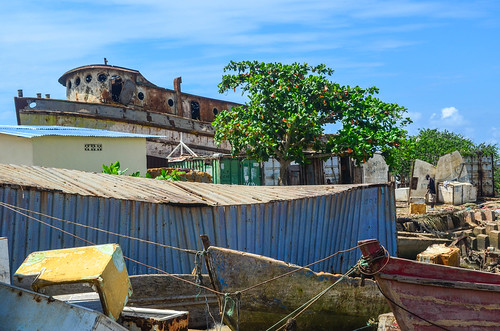
In the morning, I am at the playa at 7:30 and hope that a chata will leave for Soyo today. I can’t take another wasted day, and fortunately, one is leaving! But only at 12. Fernando visits me again and we go for breakfast. From 10 to 12, I am waiting at the playa, sitting among people drinking, cops, bad odors, trash, a dirty beach, the burning sun, people asking me the standard questions, and the usual super smart guy who knows nothing but who likes to talk a lot, and who explains to the crowd that my government pays me to tour foreign countries, that satellites follow me, and that my route is going to take me here and there …
Worse, there is this permanently-half-drunk Congolese who claims to be a refugee, who speaks English and French, and who sticks to me and starts any sentence with the now common “you know, here in Africa we are suffering” …
Finally, it’s noon. The shipment arrives in a truck and is loaded into the boat: we will carry empty glass bottles of the Super Bock beer. Right after loading the large white bags, making sounds of broken glass, I put my bicycle in. Now we finally go?
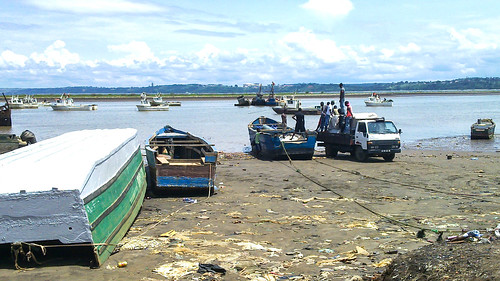
“No, we can’t leave now“. We have to wait for the tide to come in. Ah, naturally. But then, when will we leave? 6 pm. OK, that is just another wasted day waiting, the national sport. The policemen working waiting at the playa are now my friends and my Portuñol improves.
We talk about salaries. They say the lowests start at around 300 USD a month (still 3 times the African average for a policeman or a teacher) and it goes up to 2500 USD for a higher rank policeman or a teacher with a diploma. Better jobs must have indecent salaries that makes Luanda the most expensive city in the world.
For the whole afternoon, I must wait and wait again. I can’t leave my bicycle unattended so the only option is to roam around the playa. Fortunately I get a bit of distraction with the kids playing in the dirty water and exhibiting their skills (posing, swimming, doing headstands, capoeira) for my lens.
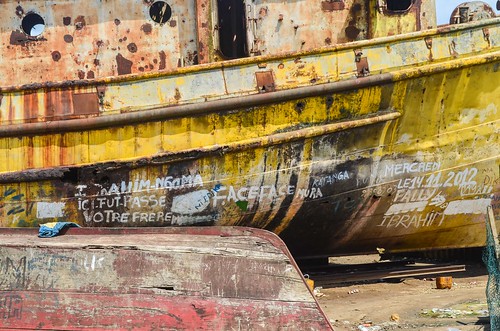



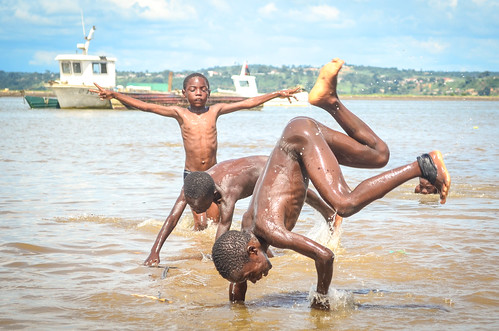
At 6 pm, the chata is not leaving yet, but at 7, ten other people show up. We board at night. We will do the journey at night. One of the crew member is completely wasted, that’s how people kill time. He is singing loud and very annoying. But I am happy, I am finally in the boat and we are soon leaving the port.
In the boat, there is also a man with his wife, two kids and an iPad. They missed the plane. They tell me the ferry used to be 25 USD, but it shut down as the current state of the port is not suited for it. I have heard the new port has been commissioned, but when will it happen … the answer for any question starting with “when” is “some time later”.
The boat has a strong smell of petrol and makes noises of broken glass as people walk over the large bags of empty bottles. Some of the passengers sit at the bottom of the chata and start eating their cassava. If we were 50 in this boat, it would totally look like illegal migrant boat.
I have had little food and little water today, but with so much waiting and feeling the helplessness of dealing with the improbable schedule of events, I am not fancying anything. I just want to get to Soyo and recover my independence of cycling on the ground. As usual in the most intense or uncomfortable moments, it is not the right time for a picture. I don’t have photos of my worst experiences, they are for my memories only.
The drunk crew member is very loud and keeps saying bullshit. As often, nobody is telling him to shut up. Rather, people will laugh alongside, as if an annoying drunk man is an entertainment and not a nuisance. At 7:30 pm, we finally cut the rope and the engine starts on the first try. Surprising eh? We leave the playa of Cabinda with the humming noise of the single speedboat engine for a large barge under the starts.
With all the platforms and ships working in the oil fields, there is so much light at the horizon that one can mistake it for the coast of Cabinda. It is not comparable with Pointe-Noire, it is so much busier. Oh, and the drunk man is still saying bullshit and nobody cares about him. I had filtered him out already.
We are navigating less than 10 meters away from the shipwrecks. I am glad I am too tired to feel hungry or to worry about being in a refugee boat that I waited for three days. I know that I will eventually reach Soyo, that I will be cycling again there, and I am focusing on this idea, nothing else. The engine can have a breakdown or the rain can pour on us, I won’t care, I am exhausted. In my mind, I am in Soyo already. I am ahead of time, but since time is an elastic and illusionary concept over here, I guess it is allowed.
19:51 : the chata boat stops. The anchor is thrown in the sea. Why? “Too many waves, we must wait for the low tide“. Pfff … anything that could possibly go wrong IS going wrong. So that makes another couple of hours waiting, but now on an uncomfortable boat deck just 1 kilometer away from the port of Cabinda. The whole trip should last about 100 km.
And during the night, the first droplets reach us. We can see the lightnings coming closer. I shelter under the large blue tarp that covers the boat. With the families already there under, I can’t find a flat spot and end up sleeping on the planks of the small front deck. We actually stop until 4 am.
It didn’t really rain during the night and we start the engine, for real this time, at 4 am. We navigate along the coast at 10 km/h. At this speed, the 100 km journey will take much more than the announced 4-5 hours.
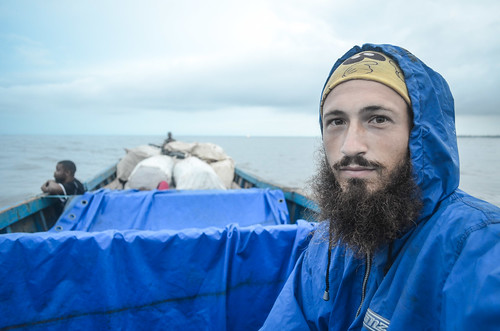
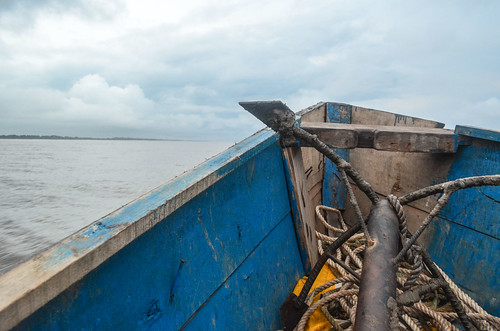
We stop along the coast, where fishermen lay their nets right next to platforms, to change the engine. I don’t know why, but usually a journey is not complete if there is no break down on the way.

I can follow our position and speed on my GPS, which provides me with accurate information, when the stories of everyone else is just fantasy. We enter the waters of DR Congo where a huge platform “welcomes” us. A helicopter is doing the shuttle with the base onshore.


Perenco claims to be the sole oil producer of DR Congo, so all the installations I see must belong to them.
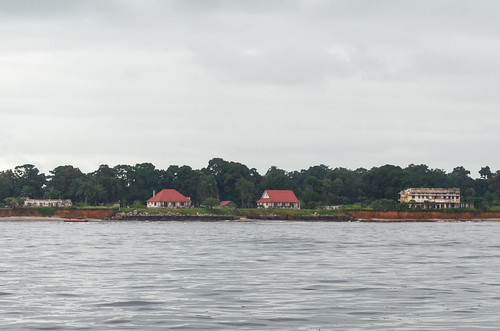
We are navigating really close to the coast. The chata now smells bad as the women and children have peed in it. Francisco, the man taking pictures with his iPad, speaks French. He says the salaries of oil workers on the platform is around 7000-8000 USD a month, but that Whites are paid better: “A friend make 11’000 USD a month while his colleague, an American, at an equivalent position with an 18-year experience, makes 41’000 USD.” Well, I heard other uncommon things, such as “Lingala is a dialect also spoken in Belgium” and “You don’t have corruption at schools in your country?“.
For numbers, I guess tens of thousands dollars a month don’t surprise anyone if people are used to see basic hotel rooms at 200 USD per night. I also hear from Angolans, and not for the first time at all, that DRC is a paradise of corruption and a very dangerous place.
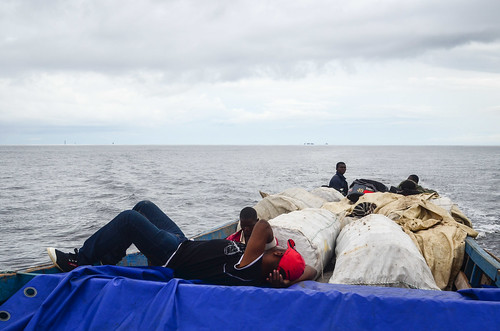
There are more and more platforms as we move forward into the DRC waters. I know exactly where we are on my GPS when I hear the passengers talking without knowledge “We are in the Congo river mouth“. I can also estimate our arrival time, which all the passengers ignore. If I tell them I know that, they will think I am a spy or that the satellites are tracking me.
We are just a hundred meters away from the Muanda-Banana road. We can see the cars and the fishermen. Once the few raindrops disappear and the clouds evaporate, it is instantly too hot. It was almost cold at night with my jacket. We already spot Soyo on the other side of the Congo river and the ugly petrol tanks with gas flares.
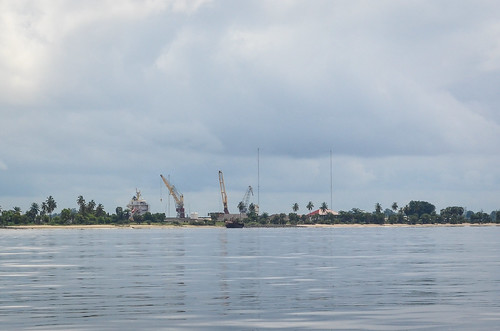
Francisco, with the iPad, snaps me while eating cassava. He wants to kill the widespread local myth that “White people cannot eat cassava“. Well, I guess it’s just that White people would rather eat good things than cassava (unless they’re cycling in the bush and there is no other food). There is another local myth to kill, as so many people think that “Whites are all rich and tourists are paid by their governments to travel to Africa to take pictures of the poor“. One myth I don’t mind is “satellites watch us permanently and they know what we eat and when we sleep“, it can be useful to scare petty thieves off.
We finally reach the Congo river mouth. During this trip, I have already crossed some of the longest rivers of Africa, including the Senegal river and the Niger river, but the Congo river is the longest. It’s Africa’s second longest after the Nile, the world’s longest river. In terms of volume of water discharged, it is the second most powerful river in the world, behind the Amazon. By the way, when Africa and South America were connected, at the time of the Gondwana supercontinent, the Congo river was believed to pour into the Amazon (which was flowing in the other direction than today).
The frontier between the Congo river and the Atlantic ocean is flagrant. There is no particular agitation, but a much brownier color, probably due to the mud transported during the rains. Google Maps also reveal the power of the river.

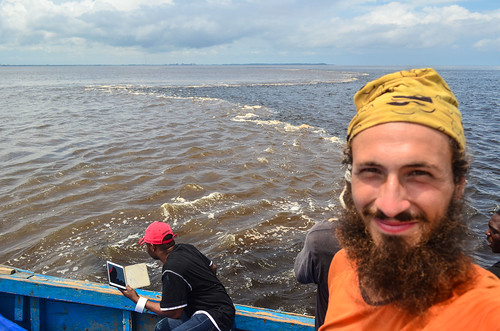
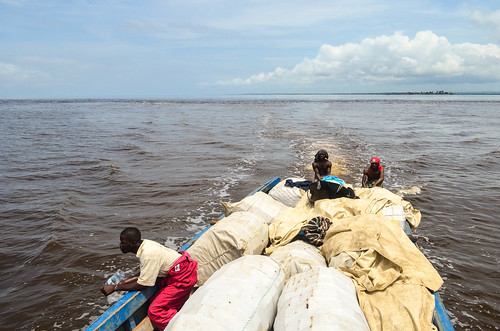
After more than an hour in the river, we finally reach Soyo alive. Ouf!
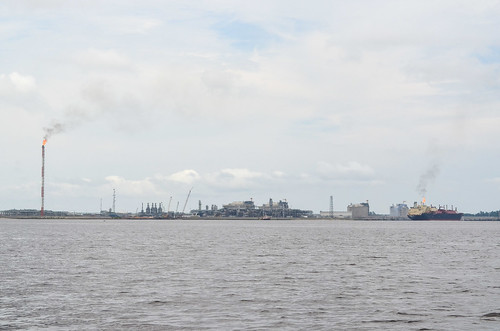
The “we leave tomorrow and the trip lasts 4-5 hours” turned to be actually three days waiting, a night on the boat in the port, and more than 10 hours navigating. I am very relieved to be on the other side as I am now sure I can cycle entirely from Soyo to Cape Town. But is it really the end of the trip?
Sadly no. We disembark in a small bay next to Soyo. The police is there on a tiny island facing the city. There are no roads from this island to Soyo, so the other passengers take a taxi-boat, a much smaller one. What do I do with my bike? Nothing, as my passport has been confiscated by the police and the crew are starting to drink beers … pfff … It can again take hours.
Luckily, the stop at the police island doesn’t last more than 30 minutes. I get my passport back and we head to the informal port. For this, we navigate inland on a river until the exit of the city, where many chatas and other moldy wooden boats are being loaded and unloaded.

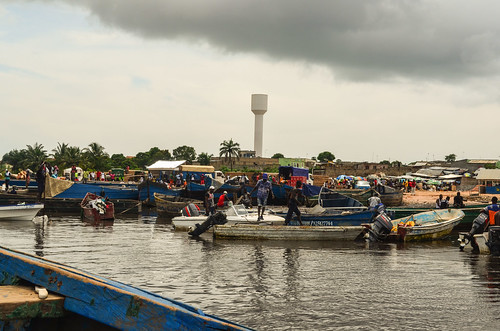
There, I finally set food on the ground! It is 14:20. I pack my panniers and load the bike: everything is fine. I am directed to the immigration police. They need to register me as Soyo is a different province (called Zaire). It is not the end of my police stories …
The policeman tells me to wait and disappears with my passport. So I wait. For a long time. The policeman never comes back, but eventually a younger one appears, with my passport, and tells me to follow him. We will just go together make photocopies at a small shop.
We have to visit many until finding one that works. There, I see something highly improbable. I kind of expected during my trip to see a commercial van (plumber, baker, carpenter, etc) from a place in Europe I know. Since many vans are “recycled” in Africa, it is often that they still carry their original advertising on it, with town name and phone numbers.
But there, something way more unlikely happens: I see a young man wearing a dark blue polo shirt, reading “Challenge 2006 altran.net” written on it. I get closer to inspect, and well … no doubt, c’est bien un polo du challenge Centrale Lyon! It is a sport competition among some French Engineering graduate schools, I was part of the organization team, and I have the same polo shirt. From my phone, I show him a picture of me wearing it. He doesn’t understand my excitement, and says his father brought him the shirt, while others claim he just got it at the friperie, where second-hand clothes from the first world end their life. Well, that encounter made my day.
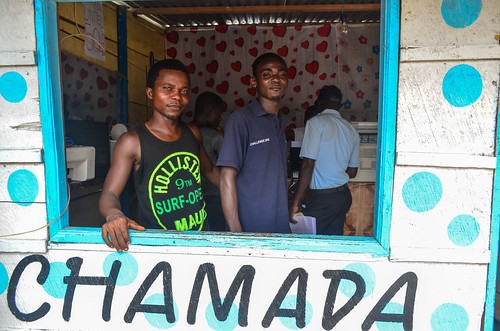
Once the photocopies are done, I say goodbye to the policeman, and quickly cycle away. I don’t even do my necessary logistics: buy food, fetch water, replace my broken USB charging cable. I just need to cycle away from this very tiresome experience.
I actually find the right cable in a small shop at the exit of Soyo. And at a more reasonable price that what I have seen. The ex-Zaire people run many shops in this region. There are many public water taps, but all broken. There is no water in Soyo! Well, I keep cycling away without water. If I can find a polo du challenge in Angola, I can find drinking water later. Hopefully. The asphalt disappears only 10 kilometers after Soyo. I was told it would last 100 km until N’zeto. Weird …. But the locals confirm it: this is a sand track until N’zeto. Then it’s tar until Luanda.
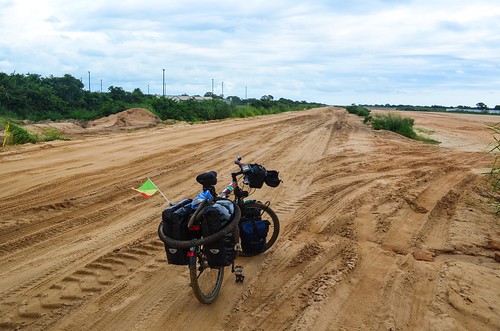
Later on this sand road, guess who shows up again? The young policeman on a scooter. He had made photocopies of my passport, but forgot to stamp it. That’s what he says. I have already explained to many that since I didn’t leave the country, I don’t need a new stamp in my passport. It seems that every immigration policeman wants to stamp my passport. These people are not the most educated, and they often don’t know how to deal with passports of foreigners. I have to teach them how visas work, and what they should do and shouldn’t. I once had to request for the stamp entering Guinea. Maybe the officer didn’t know what to do, maybe he didn’t stamp it on purpose, so that another officer asks for money later. Here, this young Angolan policeman wants to stamp my passport because I changed province. “No man, one stamp per country, and Cabinda was Angola already! You won’t stamp and sign my passport just for fun!”
In the end, he wants to make other copies of my passport because he made it black and white. His boss wants color ones.
“– So just follow me back to Soyo to make color photocopies.
– What? You want me to make a U-turn and cycle 30 extra kilometers in this sand track just because you didn’t do color copies? No way.
– So give me your passport and wait here. I will do the copies.
– What? Giving my passport away to someone who doesn’t look like he knows his job, and wait when I need to cycle? No way.”
Finally, we make the following agreement: I give him my passport, and in exchange I take his police badge and his bank debit card. I cycle on and he will catch me later. I can’t go very fast on the sand anyway. There is a large road next to the bad one, it is sand too, but harder one. It seems to be the new road under construction. The bridges over small streams are already done in concrete. I witness Chinese and Chinese camps around too, so they are probably buildings the road, although Fernando said the construction works are mostly done by Portuguese companies.
After a few kilometers, the policeman eventually catches up with me to return my passport. But he is angry, and he shows me a deep open wound under the knee, as he fell from his bike, driving too fast on the bad road. I give him my disinfecting spray and a box of paracetamol, which I don’t use anyway. What a story!
And I finally find water, at a solar-powered pump-tank system next to a huge camp of houses almost finished. They have a roof but no windows, so it will be perfect for me to sleep for the night. There is a family living there too, probably watching over the camp. But they won’t let me sleep in any of the houses and send me to the chief of the next village to ask the permission. After policemen and immigration officers calling the whole hierarchy to ask what to do with me, I start to think there is a serious problem of delegation of authority in this country!
Well, it turns out to be a good thing, as the chief of the Kavugi village, Bernardo, is very welcoming. The chief’s house is behind the national flag, as usual. As it will most likely rain, Bernardo makes me sleep inside the house and his wife makes dinner for us. I feel like I didn’t sleep for three days and I am exhausted by this whole adventure. Being welcomed and fed like this feels so good. And to end on a positive note, he brings for dinner a bottle of .. vinho do Porto!






You are a legend
Hi JB, dropping by to tell you that I loved your post!! I think more should dive in an adventure with their bikes!!
Wow. You operate on faith my friend.
I don’t have the patience, for one, to put up with the crap you got from those government “officials.”
I don’t have the courage to ride alone in areas that contain wildlife that can kill you. (I rode through ‘Yellowstone National Park” 2 years ago and feared every mile because of the grizzly bear attacks. One electronic park sign warned “bears next 5 miles / stay inside your car with windows rolled up. Do not stop.” Yeah. But what about me and my bicycle??
I don’t like riding in sand.
Did you make it to Capetown, cycling?
hola .estoy gabon ..voy en moto y quiero cruzar a angola …Rdc esta muy mal ahora y quiero evitarlo..alguien sabe si elbnarco de cabinda a soyo ya esta operativo?
gracias y suerte
Ya no estaba el ferry en 2014. Tal vez el esta reparado ahora, pero no sé.
A un viajador con moto, el ano pasado, lo paso que no puso tomar una barca artesana entre Cabinda y Soyo porque nadie queria acceptar el … El tuvo que pagar por un avion. Cuidate!
Hei!
Thanx for the long post.
I travel on public transport, so I wonder if you know about Public transport from Point Noire to Cabinda? How frequent are the buses? I assume it’s a short ride given the 100kms betweens the cities…
From what I understand security issues shouldn’t be much to worry about for the bus ride either?
AhAhah j’ai bien rigolé merci pour ton récit! Je suis actuellement au Nigeria en train de préparer ma route (en bus) pour arriver jusqu’en Angola sans passer par la rdc, et je suis tombée sur ton site!! Ça a l’air d’une sacrée aventure!! Je vais me balader sur ton site pour voir la suite 🙂
Epic!
Je veux partir en angola en voiture depart de congo c est pocible
hey man i am hitch hiking from istanbul around europe and now have made it to Conakry; heading for ghana benin nigeria and want to push forward to cape town: I read the story this boat sounds like a nightmare but doable, Ive not read on but can i manage to hitch the way to namibia , you said the roads were very quiet… Obviously buses are going to cost a fortune there eventhough petrol is pretty cheap, would you say just forget about the whole thing and give up at nigeria cameroon, because clearly DRC is a very harsh terrain to cross and head south from Tanzania… Lastly, you got that ANgola visa where ; sorry i missed that part. Please man your knowledge is really needed here, your first hand and all… even the article is opening my eyes. I only recently heard all this nonsense about Angola and Luanda beiing the most expensive city etc Mind bending shit lol. Your determination is incredible by the way , Thanks for sharing and buen camino
Angola is indeed very expensive, I’d recommend not going there if you don’t have your own tent, because even a run down hostel is ridiculously priced. If you speak Portuguese you could make friends easily and ask for hospitality. If cook your food or eat only mandioca and maize, and get rides with rich people in nice cars who understand you’re a tourist with less USD than themselves, I assume you won’t pay more than elsewhere. And the experience is very worth it. I got my visa in Pointe-Noire.
What’s true is that once you leave West Africa, the population density is much much less. In Gabon/Congo you’d have to be careful not to be stranded in remote areas, but if you take public transport it should work fine. It’s very different but well worth it too. You’ll probably struggle but isn’t it how adventure souvenirs are made?
All the best!
Hey man… thanks a lot for the response…The tent is definitely here lol.. I got one more thing I gotta ask.. Im now in Ghana and debating hard about givin in lol… been tough. scratch is getting thin. Anyways…
The visas, Nigeria, Cameroon, Gabon, Congo, Angola, Namibia.. can you remember how much you paid for each one? They are about 25 000 CFA each? 40 euros more or less?
thanks a lot bro
I’d say Central Africa is more expensive than West Africa in almost every aspect. There’s less people, less competition. You can see my list of visas here: https://freewheely.com/visas/
that visa list is perfect man, thanks so much for that really.
Why would you bother going through this constant mind-fk ………just to see dirt, plastic bottles and plantain. I’ve spent 5 years in West Africa…… and its all shite.
Super! détermination
Vive le Challenge !